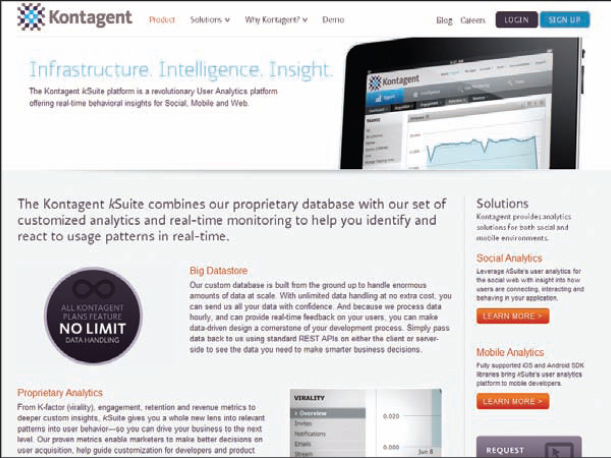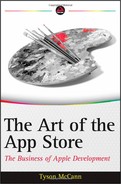TAKING CUES FROM FACEBOOK
Prior to Facebook, multiplayer gaming, chat, and even monetization was taking off, especially in Asia. Facebook took the ideas in MySpace further by tightly integrating it all in one place. See what your friends are up to and provide your own quick updates, find friends you forgot you had, develop and become invested in your user profile, share and tag pictures, and, eventually, game and compete with friends.
Because social gaming 2.0 (not just multiplayer and chat) was born and evolved via Facebook, and especially skyrocketed in popularity (thanks in large part to Zynga and other innovative social strategic gaming companies), the art of developing a social app is now a science. It may be an imperfect science still full of new discoveries, but it is also a rapidly changing process-and-metrics-driven marketing phenomenon with the potential to turn any intellectual property from unknown to globally known virtually overnight. How is this possible? Friends.
Everything Is More Fun with Friends
Developers of Facebook apps have learned the fine art of turning what would normally be single-player experiences (“Farmville”) into socially driven games. Displaced friends along one side of many games provide that sense of community and competition (even while playing solo) that would otherwise not be there. This friend presence (combined with frequent opportunities to share your experience, gift, and receive friends' items, as well as to visit your friends' worlds) provides an atmosphere almost as if they were there playing with you.
The fact that they normally are not doesn't matter, and can actually be better, because there is less pressure for competition, and more room for surprise and anticipation. Logging back onto a social game to see the progress of friends or to receive new gifts and responses lends an element of long-term retention to apps.
Just what elements to provide in your app to provide this, however, is something that will need to be constantly monitored, tweaked, and measured.
It's All about Metrics — Tweak Values Early and Often
Number 1 Facebook developer Zynga is known for taking a heavy metrics-based approach to game design, which is one of the reasons its games are immensely addictive and popular.
Brian Reynolds, chief creative officer, provided this company insight during an interview with IndustryGamers (www.industrygamers.com):
[T]he numbers give us an idea of roughly what kind of feature to do because there are some kinds of features that are more likely to drive people to pay, or to drive people to stick and come back a lot, or to invite their friends, or things like that. So, you can kind of aim a feature at different things or different combinations of things, but then you still have to have someone to be creative to make it cool and to make it fun and to make it fit into a long-term story that makes sense to people. So, I think that the metrics are something that help us make the games better.
In February 2010, at the DICE Summit in Las Vegas, Reynolds said that, for Zynga's game “Mafia Wars,” up to seven different tutorial experiences ran in parallel. “We learned all kinds of stuff about what it takes to get somebody to become a regular player. We went down to three, then one, and that one was totally counter-intuitive to what we thought the tutorial should be like.”
What he is referring to about going down different paths is called split testing, or a/b testing (both are synonymous). This is the most common method for analyzing two sets of data that two sets of random samples experienced, all other things being equal. Split testing is immensely useful for everything from testing whether product landing pages have impactful text, to banner ads, and to user engagement in games and other apps.
Any time that you can take advantage of split testing, you should — which also means getting involved in analytics for your app. The more things that can be quantitatively measured (whether in handy charts and graphs, or solid numbers), the easier it will be to take action.
Three of the leaders in analytics for both Facebook and iOS apps are AppData (for measurement and trending of Facebook apps — www.appdata.com), Kontagent (for full analytics — www.kontagent.com, see Figure 10-8), and Flurry (for full analytics — www.flurry.com). The core value in split testing is in taking the best approach, then pairing that approach with another alternative, and testing it again. That way, each process can evolve until you have the best possible, heaviest engagement, or profitable experience.

FIGURE 10-8: Kontagent is a leading metrics provider for apps and social media
For example, following are some split test examples in apps:
- Determining which keywords work better for searches
- Measuring user engagement of your app past certain barriers such as tutorials or even the main menu
- Determining how long users stay in your app
- Pricing for in-app purchases versus sales
You can split-test most anything these days, and should. In December 2010, Albert Lai (simplyalbert.blogspot.com), co-founder and President of Kontagent, provided seven important social metrics that should be measured:
- Customer Acquisition Cost (CAC) — He said that CAC is currently from $1 to $4 and trending upward because of big brands entering the advertising ecosystem, driving costs higher for the smaller developer.
- K-factor — The k-factor is how viral your app or product being measured is. That is, for a k-factor of 0.5, you are bringing one “free” new user for every two users you acquire. At a k-factor of 0.2, you'd be bringing in one free new user for every five users acquired. For an app to go viral, you must have a k-factor greater than 1.0, preferably at least 1.2 for faster and sustainable viral growth.
- Sessions per user and average session length — A session is how long users stay in your app at any one time. A higher user engagement usually means longer session length, which is good all around, especially if you're into monetizing. Lai said that Kontagent was seeing 10+ minutes and 1.7 to 2.2 sessions per user per day in its most successful apps.
- One-day + One-week retention — Take a look at how many users are coming back to your app after their first time. In addition, measure how many are coming back one week after their first use. This can be enhanced, Lai says, using a/b testing on game mechanics.
- Average lifetime per user — Focus on the engagement loop (in other words, the psychology of what makes a user want to come back). And, Lai says, end with a reminder to come back. For apps, this can be as simple as push notifications, but should be inherently embedded into the game mechanics.
- ARPU, ARPPU — This refers to average revenue per user (ARPU), and average revenue per paying user (ARPPU). Both of these, according to Lai, are trending upward as companies are learning more about virtual goods' models. These can be measured through revenue per daily active user (DAU), transactions per DAU, and dollars per transaction.
- Percentage of paying users — As production and acquisition costs rise, it is important that more users are of the paying kind, especially for freemium models or those with DLC. Acquiring users via targeted marketing is key. The typical paying user rate, Lai says, is roughly 1 percent to 3 percent of total users.
When you develop an app, you'll have access to Apple's built-in iTunes Connect data as well. However, although handy for a few statistics, you should strongly consider signing up with a third party to be able to track most anything and everything in a degree of depth that Apple doesn't currently (and may never) provide.
